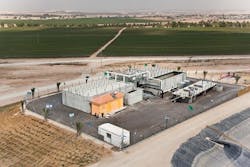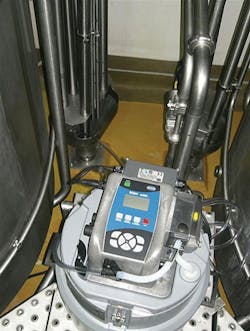Biomimicry Desalination
Singapore Takes a Leaf out of Nature's Book
True to its global hydrohub reputation, Singapore is hoping to reduce current energy requirements for membrane desalination from 3.5kWh down to a miraculous 0.8kWh/m3. PUB's chief technology officer Harry Seah addresses what role electrochemical desalting, variable salinity technology and biomimetic membranes could play in the country's water supply.
Like many developed nations, Singapore's daily water demand – currently at about 1,730,000 cubic metres or 380 million imperial gallons a day — will continue to increase with the rapid growth of Singapore's economy and urban population. In next 50 years, the water demand is expected to double with about 70% coming from the non-domestic sector.
For an island not naturally endowed with an abundance of both land and water, the sustainability of water has always been a challenge. Today, thanks to a long-term water supply strategy known as the Four National Taps (local catchment water, imported water, NEWater, desalinated water), Singaporeans have access to clean drinking water at a turn of the tap.
.As an island nation, desalination is a natural option for Singapore. Since 2005, PUB, Singapore's national water agency has been exploiting the surrounding seawater as a resource, with Singapore's first desalination plant, the SingSpring Desalination Plant at Tuas. This produces 136,000 cubic metres of potable water every day. Today, approximately 10% of the nation's total water demand can be met by desalinated water.
However, plans are already in place to increase that percentage to about 30% of the nation's total water demand by 2060. As part of this plan, a second plant – Tuaspring Desalination Plant – is scheduled for completion in 2013 to bring the total desalination production up to more than 400,000 cubic metres per day. When completed, the Tuaspring Desalination Plant will be Singapore's second and largest seawater desalination plant under a design-build-own-operate (DBOO) arrangement with Hyflux.
The plant will feature the world's second largest ultrafiltration pre-treatment membrane facility. Upon completion, the plant will supply PUB with 70 million gallons of desalinated water a day over a 25-year period from 2013 to 2038. Currently, the membrane-based separation process of sea water reverse-osmosis (SWRO) is becoming more commonplace globally. This method of desalination uses about 3.5kWh of energy per cubic metre of water produced (3.5kWh/m3). However, Singapore expects to reduce this amount to less than 1.5kWh/m3 in the short-term with the application of new desalination technologies. Here's how.
"Electrifying" Desalination: Eletrochemcial Desalting Plant
Back in 2008, Siemens won a grant from Singapore's Environment & Water Industry Programme Office to build a demonstration unit that could desalinate seawater to drinking water quality, using just 1.5 kWh of power for each cubic metre of water that it produced. That energy demand is less than half that used by the best available seawater desalination technologies today, which typically lies in the 3.4–4.8 kWh/m3 range.
Siemens decided to move away from current seawater desalination technologies, which typically use high-pressure pumps to force water through membranes. Instead, they turned to electrochemical desalination, which uses an electric field to push sodium and chloride ions—the constituents of salt—across ion-exchange membranes and out of the water.
As the water doesn't go through the membranes, the processes can be run at lower pressures, resulting in a lower power consumption. Such systems are already used to desalinate mildly salty brackish water, but until now have never been made efficient enough to treat seawater.
Since December 2010, the Siemens demonstration unit has been treating 50 m3 of seawater per day at a PUB facility in Singapore. The unit is successfully producing drinking water from seawater using approximately 50% of the energy required by the most efficient desalination technology available today.
Heating it up: Memstill Plant
PUB is also working with the local firm Keppel Seghers to develop the Memstill® technology, based on membrane distillation. Memstill is able to utilise waste heat to produce drinking water from seawater. This technology allows seawater to evaporate at low temperatures, and the water molecules are transported in the vapour state through a hydrophobic membrane to be condensed and collected as drinking water. By tapping the large amounts of waste heat produced in Singapore's mega-industrial complexes, this one-step Memstill process can reduce the energy needed for seawater desalination to a third of the current value. PUB and Keppel Seghers have constructed, and are currently commissioning, the first Memstill demonstration plant on Jurong Island to further study and optimise the technology.
The Perfect Match: Variable-Salinity Plant (VSP)
The development of the variable-salinity plant (VSP) technology by PUB was driven by the need to make better use of the considerable amount of rainwater going to waste at smaller drains, situated at the outskirts of the island. During the rainy season, these tiny streams routinely brim with water that could be collected in canals, but during most months they can run completely dry. Indeed, some parts of the island see only minimal rain for up to four-fifths of the year.
The construction and maintenance of a full-scale water-processing facility at sites that could achieve only meaningful productivity for several months per year would not be cost effective, but neither would a smaller plant that cannot achieve the high throughput required after a heavy downpour.
Therefore, to balance the two extremes, PUB pioneered a technology called VSP. Not only can VSP effectively process collected brackish rainwater, it can also adapt to changes in precipitation by switching over to seawater desalination during dry spells. The use of the VSP resulted in considerable savings, with an average energy usage of 1.9 kWh/m3 of water rather than the predicted 2.99 kWh/m3. Notably, the VSP also proved more efficient than a typical seawater desalination plant with approximately 50% lower energy consumption.
Although VSPs are designed to produce potable water, the product water can also be supplied to the industries for non-potable use (as is the case for the current test plant). These plants will play a crucial role in bolstering Singapore's water supply as it is expected that further expansion of VSP operations will ultimately enable PUB to turn as much as 90% of the island's land area into catchment area.
The Future of Desalination
With further breakthroughs in research and development, the long-term target set by Singapore is to reduce desalination energy consumption to 0.8kWh/m3. One of the technologies which PUB is looking into to achieve that target is the use of Biomimetic membranes/Biomimicry in desalination plants. The principle of such applications is adopted from plant and animal life which have been extracting sea water for their survival evolved over millions of years, using negligible amounts of energy.
If science can find a way of mimicking these biological processes, innovative engineering solutions can potentially be derived for seawater desalination. Seawater desalination can then be transformed beyond our wildest imagination. There can be potentially lower costs of desalinating water, strengthening the viability of desalinated water as an affordable water source.
The Global Hydrohub
The Four National Taps are in place today because of PUB's foresight in investing in research and development over the last 50 years. Notwithstanding this, PUB continues to invest in research & development and new technologies to find even more cost-efficient and effective ways of treating and producing water to ensure a sustainable water supply for future generations.
Recognising the potential for Singapore to become a leader in the water sector, the Singapore Government has identified water as a strategic growth sector in Singapore with R&D as the key driver. To promote research and development in this field, the Environment and Water Industry Programme Office (EWI), which spearheads the growth of Singapore's water industry, is investing $470million from Singapore's National Research Foundation in water R&D. Through funding promising research projects, the EWI aims to foster leading-edge technologies and create a thriving and vibrant research community in Singapore.
Investments in Singapore's water sector in the last couple of years have paid off, with a vibrant water ecosystem comprising more than 70 local and international water companies These include not only Singapore-owned companies like Hyflux, Keppel and Sembcorp but also international names like Black and Veatch, CH2M Hill, CDM, General Electric, Siemens, Veolia and Suez. A thriving water research landscape with 25 research centres undertaking projects in various domains like membrane technology, energy-efficient used water treatment and low energy seawater desalination also adds to the vibrancy of the water industry in Singapore.
In line with efforts to grow Singapore into a hub for water technologies and research, EWI also strives to promote Singapore as a global test-bed. PUB offers opportunities for water companies to test-bed their new technologies and solutions at its facilities under actual site conditions. A total of 114 projects involving the test bedding of water solutions have been facilitated at PUB's installations, and more than 30 test-bedding projects are currently on-going at PUB's facilities.
Author's note: Harry Seah is the chief technology officer of PUB in Singapore.
More Water & WasteWater International Current Issue Articles
More Water & WasteWater International Archives Issue Articles


